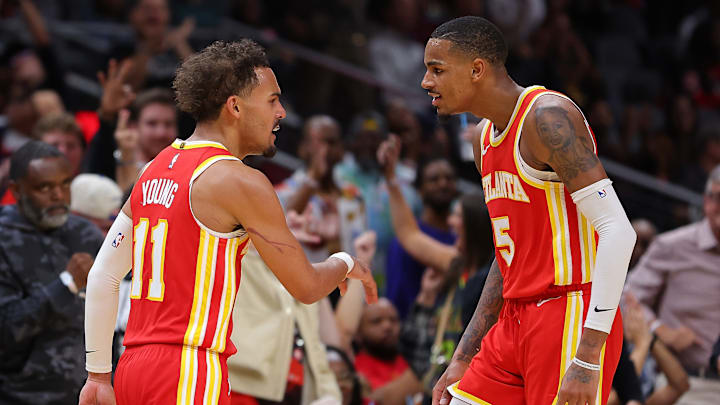When the Atlanta Hawks traded Dejounte Murray to the New Orleans Pelicans, they embraced the concept of addition by subtraction. Sometimes, less is more in the NBA. In the case of Murray’s departure, less isolation basketball should lead to more Hawks success.
Hawks fans have been very divided about the Murray trade. Many have questioned or hated the move, and others have embraced it. While many fans have valid concerns over losing a talent like Murray, there is no denying that Trae Young and Murray underwhelmed as a duo. The Young/Murray pairing went 55-62 across two regular seasons and just 1-4 in playoff games during that time.
When Murray first arrived in Atlanta, he and Young looked like a promising backcourt with sky-high potential. Unfortunately, their games did not fit well together in the long run.
At Murray's introductory press conference, Hawks general manager Landry Fields said, "This is a big day in Hawks history."
"This is a big day in Hawks history."@ATLHawks GM @landryfields introduces @DejounteMurray.
— Bally Sports: Hawks (@HawksOnBally) July 1, 2022
📲 https://t.co/drIoKp4KAP pic.twitter.com/92UY2P3fqw
Both Young and Murray needed the ball in their hands to dominate, which turned the Hawks into a team doomed by poor ball movement. Despite the individual playmaking abilities of their star guards, the Hawks ranked bottom-ten in passes per game and No. 15 in assists per game.
In the modern NBA, isolation basketball does not equate to winning at the highest level. The last five NBA champions have ranked at least top-five in assists per game in the playoffs, and so have eight of the last 10.
Dejounte Murray's isolation playstyle meshed poorly with Trae Young
Murray ranked top-15 leaguewide in both isolation possessions per game and isolation frequency. His iso-heavy playstyle and ball-dominant tendencies did not mesh well with Young’s established role as Atlanta’s go-to ball handler and offensive engine.
While the Hawks can benefit from leaning on multiple players to create offense, their offensive process needs to look a lot cleaner than it did last season. After shooting better than 37% from the 3-point line in the 2020-21 and 2021-22 seasons, the Hawks dipped to 35.9% during Murray’s two years with the team.
Much of the Hawks' shooting struggles stem from their lack of consistent ball and player movement. These flaws became apparent in the Young-Murray era, but Atlanta still showed glimmers of hope in the passing department from time to time.
Beautiful ball-movement 🤩
— Hawks Nation (@HawksNationCP) March 1, 2023
pic.twitter.com/FETXamW8iw
While the Hawks did raise their volume of 3-point attempts last season, they only ranked No. 19 in drives per game. The year they last made the conference finals, the Hawks were near the bottom of the league in 3-point attempts but nailed an impressive 37.3% of them. They also ranked in the top half of the league in drives per game that year.
The Hawks need to rediscover a healthy mix of long-range jumpers and drives to the basket. Some teams thrive behind a high volume of threes, as evidenced by the Boston Celtics and Dallas Mavericks leading the NBA in 3-point attempts last season. On the other hand, only one other team ranked top-10 in 3-point attempts even won a playoff series.
The key to success for the Hawks will lie in the way they create their threes. If head coach Quin Snyder is committed to a perimeter-oriented attack, he will need to infuse more drive-and-kick shot creation into his offense. Murray’s love for the contested midrange jumper did not translate to such an approach.
Improved spacing would do wonders for the Atlanta Hawks
With No. 1 pick Zaccharie Risacher’s promising jump shot and the improving range of Jalen Johnson, the Hawks could transform their offense back into a more efficient long-range assault. However, they could really use more spacing at the center position in the form of either Onyeka Okongwu or Johnson as a small-ball five.
“5 out” offense seems like the future of the NBA, and the Celtics showcased this to the highest degree with the floor-spacing of Kristaps Porzingis and Al Horford. Teams like the Oklahoma City Thunder and the Denver Nuggets also possess shooting at all five positions, though Denver does not prioritize 3-point volume.
Some degree of spacing and floor-stretching at every position could do wonders for a Young-led offense, and the Hawks front office certainly has enough trade ammo to make another splash this summer.
All in all, the Hawks needed to shake things up. Their offense became stagnant last season as they settled for too many jumpers and failed to put enough pressure on the rim. Breaking up the Young/Murray duo and its clear fit issues could revive Atlanta’s offensive rhythm. Most important of all, the Hawks can rebuild their identity – or build a new one.
With the arrival of Risacher and an unfinished offseason of endless possibilities, Hawks fans should have high hopes for the future.
